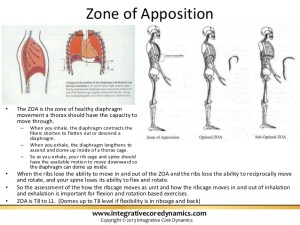
Having a healthy thoracic volume will improve the core’s symbiotic relationship to the upper and lower body, as well as assist in creating rotational movement, which is necessary for long-lasting joints.
Apposition defined: the positioning of things or the condition of being side by side or close together. The zone of apposition refers to the relationship of the diaphragm to the pelvic floor. So essentially, the ribcage to the pelvis (though there are other diaphragms, lets focus on these two cavities for now). In order to maximize breath efficiency, and core connection, its important to have a ribcage, diaphragm, pelvis, and pelvic floor muscles that work in unison and also in close proximity to each other. Hence, the “zone of apposition”. Notice the middle image below and how the buckets of the upper and lower regions stack equally on top of one another. Maintaining this integrity helps to create less spinal compression, and increased core recruitment for all physical activities. The left and right image demonstrate inefficient postural and movement patterns.

Alignment refers to having a center of gravity that is well organized. This will make all nervous systems (digestive, circulatory, hormonal, skeletal, psychological, musculoskeletal, neural) function at more optimal states.
Why it matters: As mentioned in my previous post, a better ribcage to pelvis relationship will only yield positive benefits to your physical and psychological structure. It will help you create proximal stability of your spine, which will then allow for distal mobility of the shoulders and hips. So if you’re trying to improve tissue elasticity and joint range of motion, you’ve got to figure out how to improve and better align your zone of apposition. If the relationship of the diaphragm and pelvic floor muscles improves, than your ability to create intra-abdominal pressure will also get better. Once you can accomplish this, core integration can finally happen.
Below is a video I put together to decrease the rib flare in a passive setting. This is considered a corrective breathing exercise and should be used as a warmup or daily ritual. Applied breathing is when we take the corrective and apply it to a movement and or standing based scenario. If you can begin to employ this technique on your own, before exercise, and whenever you have down time you will experience physical and psychological benefits to better heal your body. My suggestion is to begin with observation of where you are at, and use that observing to promote a sense of healing and well-being in your body.
4-Dimensions: The Big ‘D’
The diaphragm is one of the only muscles that moves 3-dimensionally all of the time, that is, front to back, side to side, and top to bottom. If we ever hope to “free” ourselves from “inflexibility” or joint compression, it is imperative that we understand the diaphragm and how it works. From your armpits to your hip-pits, to feel how your breath relates to the throat, abdomen, and pelvic movements. The fourth dimension is time, and if we can ‘mobilize’ our diaphragm to a place where it functions in tandem with the cervical and pelvic diaphragms, we will be able to move better, stand taller, and experience less discomfort when confronted with movement demands. Beyond the physical, breath control, and diaphragmatic breathing helps to regulate blood flow, heart rate, parasympathetic nervous system activation, organ functioning and several other beneficial attributes people want for long-term sustained health.
Sustainability
Having been in the training realm for 12 years now I’ve got to say that if we can regulate, modify, and adapt our breathing mechanics we will experience healthier joints and stronger, longer, more pliable muscle tissues. The body builds itself best when we do it form the inside out, the bottom up, and top down. By shifting our focus to regular breathing practices, intra-abdominal pressure comprehension, and spinal segmentation we will be able to foster an improved sense of self without unnecessary friction and stress.
Please, try this for yourself. Do it on your own, with a friend, and improve your understanding of your breath and diaphragm. Sustainability is the key. Your body has a shelf life, and what you do today, and everyday, will determine how long you will maintain its’ uprightness and ‘spring’.
Get breathing.
-Rob


Hi Rob ,
Thank you for the awesome article on this important topic. You mention about the exhaling press the lumbar down toward the floor that would be loosing the neutral curl of the lumbar. Doing this way would be better for people having too much anterior pelvic tilt isn’t ? Would it be better if we can keep the neutral spine right while doing this ? Thanks Rob .
Regard ,
Patrick
Is it too late to fix my rib cage? I am 21 years old. I have terrible back pain in the thoracic spine area between my shoulders and spine on both sides, all day long. It has been like this for a little over a year.